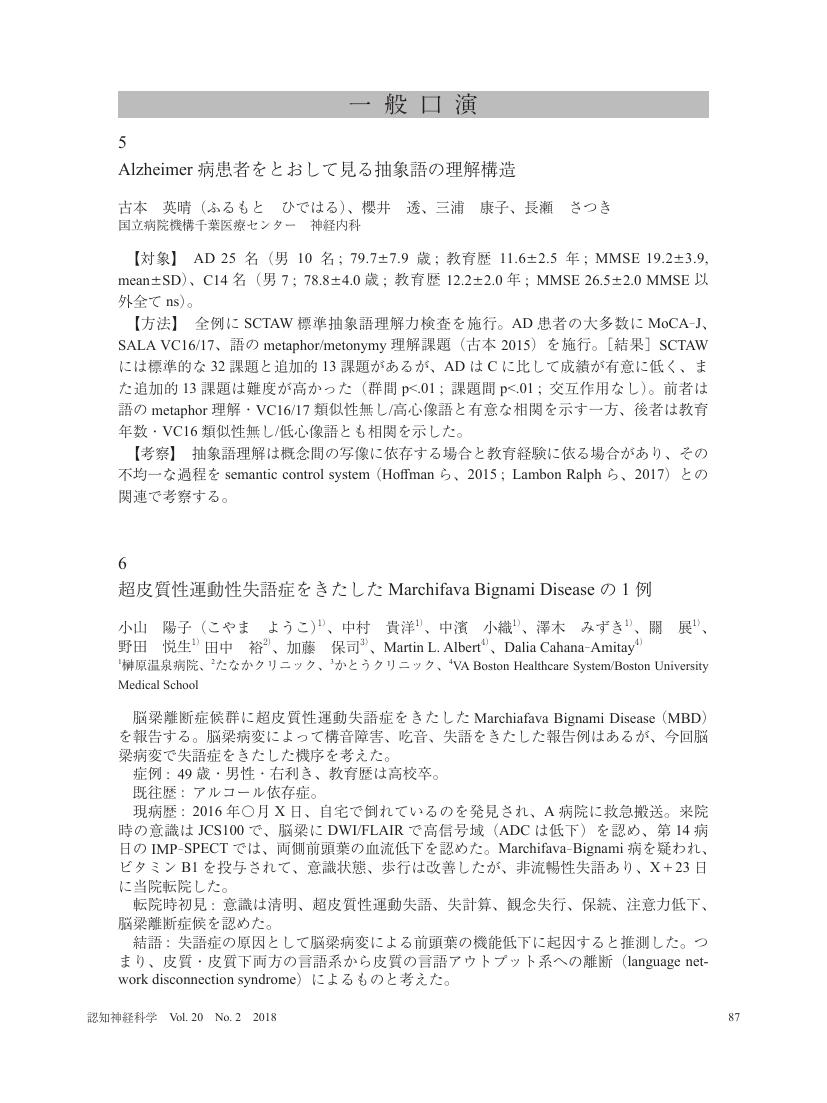1 0 0 0 OA Alzheimer病患者をとおして見る抽象語の理解構造
1 0 0 0 OA 反響言語・補完現象といわゆる環境依存症候群
- 著者
- 古本 英晴
- 出版者
- 認知神経科学会
- 雑誌
- 認知神経科学 (ISSN:13444298)
- 巻号頁・発行日
- vol.7, no.1, pp.70-79, 2005 (Released:2011-07-05)
- 参考文献数
- 48
【要約】明確な超皮質性失語を伴わずに反響言語・補完現象を呈した3症例を呈示した。2例は両側前頭葉内側面病変で、検査状況の下でのみ、主治医によってのみ誘発される状況依存性のimitation behavior(IB)とutilization behavior(UB)を伴った。もう1例は右側頭葉・左前頭葉内側面皮質下白質病変で、前2例に比して反響言語・補完現象は軽度であり、IB・UBも軽度で、その傾向を示すに留まった。反響言語・補完現象が失語症状と独立して発現することから、反響言語・補完現象は言語行為におけるIB・UBの表現型であり、単純な自動言語ではないと考えられた。また単なる環境ではなく状況に依存して反響言語・補完現象・IB・UBが変化する点から、意味機能の歪みが反響言語・補完現象を含む全ての反響行為の基礎にあると考えた。反響言語・補完現象が失語症と分離して生じる点は、言語機能が一般的な情報処理過程(制御過程)の集合である可能性を示唆し、また観察された状況依存性と意味機能の歪みは意味の階層構造の一端を示すと考える。
1 0 0 0 OA 道具使用におけるヒトの脳内情報処理過程の構造についての試論
- 著者
- 古本 英晴
- 出版者
- 日本認知科学会
- 雑誌
- 認知科学 (ISSN:13417924)
- 巻号頁・発行日
- vol.7, no.3, pp.210-222, 2000-09-01 (Released:2008-10-03)
- 参考文献数
- 49
- 被引用文献数
- 1
Although many cases have been reported on impairment of tool use and behavioral disturbance due to brain damage, the precise brain mechanisms regulating human behavior are still unknown.In this report, an outline of behavioral abnormalities caused by brain damage, including utilization behavior (UB), imitation behavior (IB), and apraxia are presented. Next, a case of UB and IB elicited only by a key person is reported, and interpretation of his symptoms is discussed. Lastly, the general structure of information processing in the human brain for tool use and behavior are discussed. I speculate that there are two distinct systems in the human brain, that is, a control system and a substantial information processing system. The former corresponds to attention and emotion. This distinction should have importance when considering tool use and behavior in human beings.A right-handed, 70 year-old man suffered bilateral anterior cerebral artery occlusion that resulted in bilateral frontal lobe infarction. He was inert, and his attention was impaired. He showed typical UB and IB which were elicited only by his chief physician and only in examination situations. Both UB and IB were lacking in his daily life and were never elicited by his family members or other medical personnel. Another report also gives evidence of cases in which a key person is required for UB and/or IB to be elicited.Generally, an object could be considered to always show its meaning as a tool, which implies that its affordace emerges from the object itself. The behavior presented by the key person also can be regarded as a releaser for the patient to imitate behavior. Thus his essential impairment can be attributed to failure to grasp the correct relation of the meaning of objects or of behaviors and situations. This should be called a type of semantic impairments.On the other hand, the patient's inertia and impaired attention is indicative of emotional disturbance. In fact, his cerebral lesions involve some parts of the limbic system. This suggests that he lost active perception which resulted in his being very easily captured by external stimuli. His unique symptoms should not be attributed to the traditional explanation in which UB and/or IB emerge from simple disinhibition of the parietal lobe function from the frontal lobe function.
